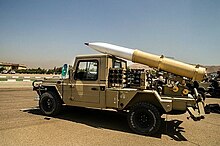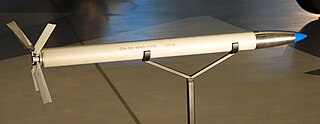
The Mk 4 Folding-Fin Aerial Rocket (FFAR), also known as "Mighty Mouse", is an unguided rocket used by United States military aircraft. It was 2.75 inches (70 mm) in diameter. Designed as an air-to-air weapon for interceptor aircraft to shoot down enemy bombers, it primarily saw service as an air-to-surface weapon. The FFAR has been developed into the modern Hydra 70 series, which is still in service.

The RPO-A Shmel' is a man-portable, single-use, rocket-assisted thermobaric weapon. Despite the literal translation referring to the weapon as a flamethrower, it does not produce a jet of burning liquid - it is in fact an unguided rocket launcher that fires rounds that explode into a cloud of very hot gases.
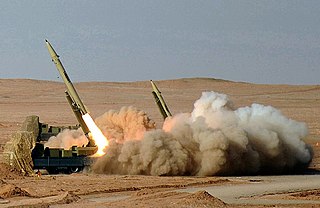
The Fateh-110, also known as NP-110 is an Iranian solid-fueled surface-to-surface ballistic missile produced by Iran's Aerospace Industries Organization since 2002. It is single-stage, road-mobile and can carry a high-explosive warhead of up to 500 kg. Four different versions, the Fateh-110A, 110B, 110D-1 and Fateh-E Mobin were developed with varying accuracy. The latest version, first shown to the public in August 2018 reportedly has a range of 300 km is reportedly more accurate than previous versions.
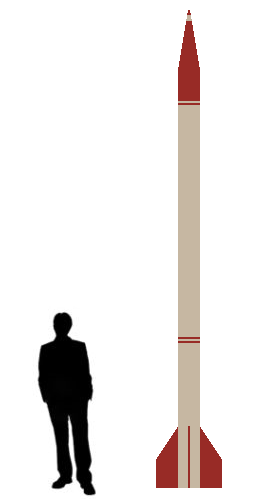
The Iranian Oghab sometimes spelled as Akab and Okab missile is an unguided 230 mm (9 in) artillery rocket with a range of 34–45 km (20–28 mi). It is spin-stabilized in flight but has a proven circular error probable in excess of 500 m (1,500 ft), making it a highly inaccurate weapon. It carries a 70 kg (150 lb) high explosive fragmentation warhead, though it may also be able to carry chemical warheads. According to US sources, a modified version has been developed that could be carried and fired from Iranian Air Force F-14 Tomcat and F-4 Phantom II aircraft. The launcher is an elevatable triple-rail launcher assembly fitted to a Mercedes-Benz LA 911B 4×4 truck chassis.

The Fajr-3 is an Iranian heavy 240 mm intermediate-range multiple-launch artillery rocket (MLRS). The Fajr-3 is a license-built copy, with slight modifications, of a North Korean MLRS called the M-1985. The Fajr-3 was introduced in the 1990s and has since been exported to Hamas and Hezbollah.

The Fajr-5 is an Iranian 333 mm long-range multiple launch rocket system (MLRS). The Fajr-5 was developed during the 1990s and has since been exported to various armed actors in the Middle East.

Zelzal-2/Mushak-200 is an Iranian unguided long-range artillery rocket. The Zelzal-2 is a 610 mm truck-launched rocket that has a payload of 600 kg and a range of about 200 km. Development of the Zelzal series began in 1990 and the Zelzal-2 was first shown in 1998. It is developed from the Zelzal-1 and was developed into the Zelzal-3. It has been exported to Syria, Hezbollah, and the Houthis, and has seen combat use in the Syrian Civil War and Yemeni Civil War.
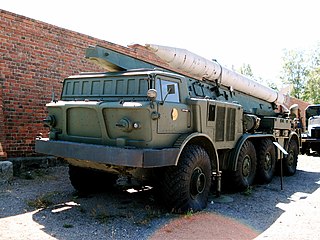
The 9K52 Luna-M is a Soviet short-range artillery rocket system which fires unguided and spin-stabilized 9M21 rockets. It was originally developed in the 1960s to provide divisional artillery support using tactical nuclear weapons but gradually modified for conventional use. The 9K52 was eventually succeeded by the OTR-21 Tochka.

The Falaq-1 missile is an Iranian made rocket system. It was developed in the 1990s by Shahid Bagheri Industrial Group, which is part of the Aerospace Industries Organization.
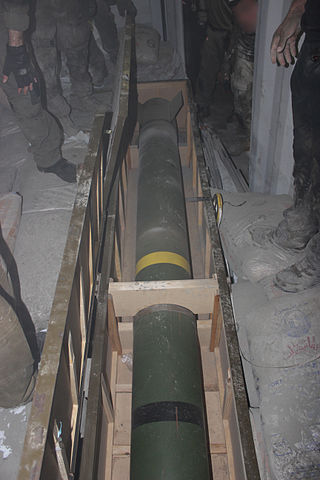
The Khaibar-1, also known as the Khyber-1, M-302, B-302 and the R160 is a Syrian-made 302 mm unguided artillery rocket. It is best known for being used by Hezbollah against targets in northern Israel during the 2006 Lebanon War, and has also been used in the Syrian Civil War. It is a derivative of the Chinese WS-1 rocket.

The Weishi family of multiple rocket launcher systems were mainly developed by Sichuan Aerospace Industry Corporation in Chengdu, China. The systems include the 302 mm (11.9 in) WS-1, the improved 302 mm (11.9 in) WS-1B, the 122 mm (4.8 in) WS-1E, the 400 mm (16 in) WS-2, as well as many other models. The WS-1 series weapon system did not enter PLA service and has order from Thailand. The WS-2 may finally see PLA service in the future. It's worth noticing that although sharing the same name, there are other developers for different models of Weishi series multiple rocket launchers (MRL) other than the primary developer SCAIC.
The A-100 is a 300 mm (12 in), 10-tube multiple rocket launcher developed by Beijing-based China Academy of Launch Vehicle Technology for the Chinese PLA ground forces. It is a derivative of Weishi Rockets WS-1 with simple cascade terminal inertial guidance.

A precision-guided munition is a guided munition intended to precisely hit a specific target, to minimize collateral damage and increase lethality against intended targets. During the First Gulf War guided munitions accounted for only 9% of weapons fired, but accounted for 75% of all successful hits. Despite guided weapons generally being used on more difficult targets, they were still 35 times more likely to destroy their targets per weapon dropped.

The Type 63 multiple rocket launcher is a towed, 12-tube, 107mm rocket launcher produced by the People's Republic of China in the early 1960s and later exported and manufactured globally. Although no longer serving with active infantry units, the Type 63 is still in People's Liberation Army service with specialized formations such as mountain infantry units and special forces detachments. The Type 63 was widely used in the PLA until the late 1980s. It was adopted as the successor of the Type 50-5 of 102mm.

The Arash is a series of 122 mm (4.8 in) unguided artillery rocket developed by Iran. It is a copy of BM-21 Grad. A guided version for the Iranian Defense Ministry was recently tested.
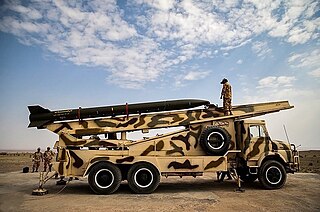
The Naze'at 6-H and Naze'at 10-H/Mushak-120/Iran-130 are two Iranian long-range artillery rockets with ranges of about 100 km. The Naze'at 10-H is larger, more powerful, and has a longer range than the Nazeat 6-H. Like Iran's similar shaped Zelzal rockets, Naze'at rockets do not have a guidance system. Both systems are also widely known without the -H suffix, as the Naze'at 6 and Naze'at 10. The Iranians also have developed another 500 kg version called the Mushak-160 with 160 km range.
The Shahin-1 and Shahin-2 are Iranian road-mobile truck mounted short-range fin-stabilized unguided 333 mm Artillery rockets. It was designed to be a cost-effective unguided rocket to destroy enemy troop concentrations, installations and fortifications at medium ranges. The rocket has been replaced in production by more capable artillery rockets however it is still in active uses.
The Noor or Arash 3 is an Iranian 122 mm fin-stabilized artillery rocket. It is speculated to be an Iranian variant of a Chinese or Russian 122 mm artillery rocket.
